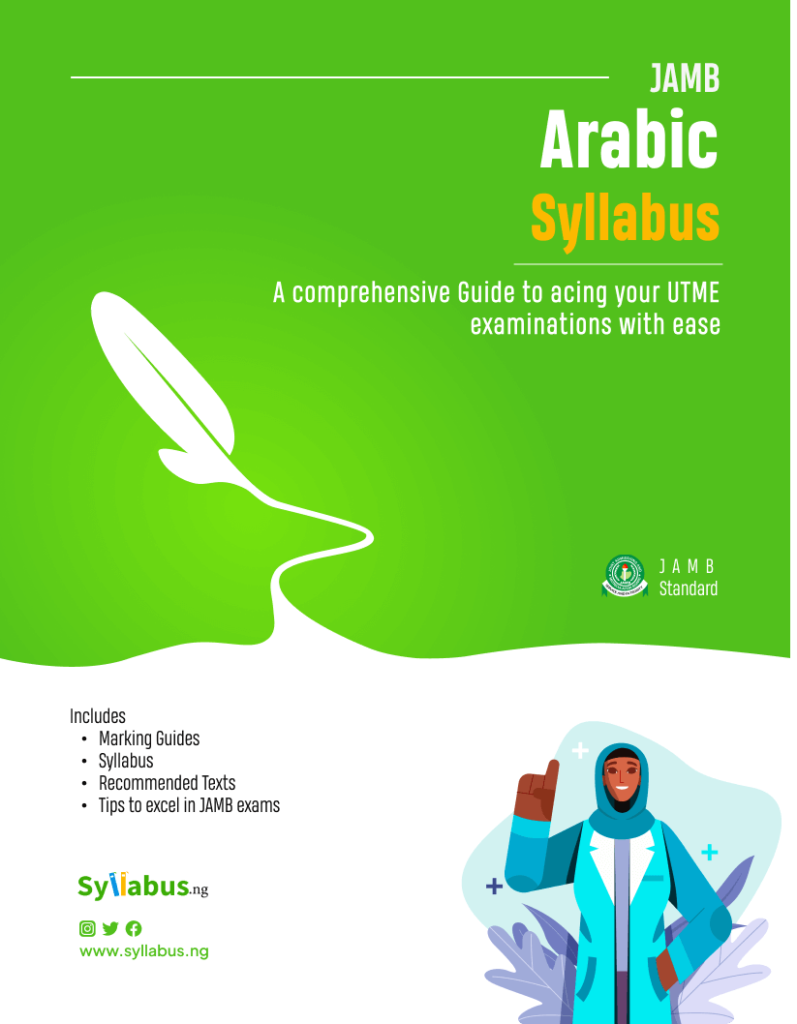JAMB Arabic Syllabus
Don’t waste your time by reading without direction! Download this UTME Arabic Syllabus to study smart and excel in your exams

Home » JAMB Syllabus » JAMB Arabic Syllabus
Home » JAMB Syllabus » JAMB Arabic SyllabusWriting Arabic in JAMB Exams
This syllabus is a must-read if you have chosen or are considering choosing Arabic as part of your JAMB exam subject combination. Arabic is widely spoken across the Middle East and North Africa and is quite beneficial for all who want to have careers in international relations, Islamic Studies, diplomacy, and business.
This syllabus is a roadmap telling you what to expect on the day of your exam.
When you study your syllabus and go through your past questions often, be rest assured that the exam will be like a walk in the park for you.
Marking Guide
The JAMB exams has a total of 180 questions. Use of English is 60 questions while the other 3 subjects will be 40 questions each. All subjects aside the Use of English is graded 2.5 marks.
For example:
If you got 30 questions correctly in JAMB use of English, your mark will be 30/60 × 100 = 50.
If you got 28 questions over 40 in your Arabic exam, the calculation will be 28 x 2.5 = 70% (in percentage).
If you have 30 in Accounting and Economics, it’ll be 30 × 2.5 = 75
So let’s add it all: 50 + 70 + 75 + 75 = That’s 270 over 400.
Objective
The aim of the Unified Tertiary Matriculation Examination (UTME) syllabus in Arabic is to prepare candidates for admission into tertiary institutions through the Board’s examination. It is designed to test their achievement of the course objectives, which are to:
- Answer comprehension questions correctly in standard Arabic;
- Translate simple texts from English to Arabic and vice versa;
- Apply the rules of Arabic grammar functionally;
- Appreciate Arabic literary texts within the contexts of their environment and eras;
- Use Arabic as a living world language in communication where necessary.
Download JAMB Recommended Arabic Syllabus

Excelling your JAMB Arabic exams starts from knowing what’s expected of you.
Don’t be left behind. Download the Syllabus today.
Arabic Syllabus for JAMB Exams
| ARABIC | ||
|---|---|---|
| SN | TOPICS | OBJECTIVES |
| 1 | COMPREHENSION | |
| It consists of a passage of seventy (70) words. Five multiple-choice questions are to be set on the passage. The contents should be within the experience of the candidates e.g. current affairs, sports, education, politics, economy, health, culture, and ethics. The themes of the two passages should vary. | Candidates should be able to: i. use appropriate words or phrases for specific thought; ii. deduce the lesson in the passage; iii. determine the main theme of the passage; iv. give an appropriate title of a passage; v. interpret the meanings of particular words | |
| 2 | TRANSLATION | |
| This section consists of ten (10) questions. Five of them are on translation from English into Arabic while the other five are on translation from Arabic into English. Translation into English includes keywords and phrases in a sentence. Translated questions are to be based on standard Arabic and English usage. | Candidates should be able to: i. use an appropriate Arabic word or phrase to convey the meaning of an English word or phrase; ii. determine an appropriate English word or phrase for an Arabic statement; iii. interpret idiomatic expressions in both Arabic and English; iv. transfer ideas expressed in Arabic to English and vice versa; v. communicate effectively in Arabic and English. | |
| 3 | GRAMMAR | |
| Major grammatical features in Arabic to be examined include: 1 .أسماء اإلشارة والموصولة. 1. Demonstrative and relative pronouns. 2 .المذكر والمؤنث2. Gender (Masculine and Feminine). 3 .عالمات االسم3. Characteristics of a noun. 4 .المثنى. 4. Dual. 5 .الجموع: 5. Plurals: أ – جمع المذكر السالم. a. sound masculine plural ب – جمع المؤنث السالم b. sound feminine plural ج – جمع التكسير c. broken plural 6 .المضاف والمضاف إليه. 6. Construct phrases. 7 .الضمائر المنفصلة و المتصلة 7. Separable and inseparable pronouns. 8 .التوابع: 8. Appendants: أ – النعت. .adjective. a ب – العطف. b. .conjunction. c. the permutative. .البدل – ج د – التوكيد. d. emphasis. 9 .حروف الجر 9. Prepositions. 10 .الفعل الالزم والفعل المتعدي. 10. Transitive & Intransitive verbs. 11 .الفعل الماضى 11. The perfect verb. 12 .الفعل المضارع: 12. The imperfect verb: a. the indicative. المرفوع – أ b. the subjunctive. المنصوب – ب c. the jussive. .المجزوم – ج 13 .الفعل األمر. 13. The imperative verb. 14 .النواسخ: 14. The modifiers: أ – كان و أخواتها a. Kana and its associates ب – إن و أخواتها b. Inna and its associates ج – ظن و أخواتها c. Zanna and its associates 15 .الفعل الثالثي المجرد و المزيد فيه. 15. Trilateral and derived verbs. 16 .المشتقات: 16. Derivatives: أ – اسم التفضيل. a. the comparative/superlative. ب – اسم اآللة. b. nouns of the instrument. ج – اسما الزمان و المكان c. nouns of time and place. د – اسم النسبة. d. relative adjectives. 17 .الجملة الشرطية 17. Conditional sentences. )فقط 3000 – 1( العدد. 18 18. Numerals (1 – 3000). 19 .الفاعل و نائب الفاعل. 19. Active and passive voice. 20 .منصوبات األسماء: 20. Nouns in the accusative أ – المفعول به. a. direct object. ب – المفعول فيه )ظرف(. b. adverbs of place and time. ج – الحال. c. adverb of circumstance. د – المستثنى بإال. d. the exempted with illa. هـ – التمييز. e. specification. و – المنادى. f. the vocative | Candidates should be able to: i. identify the various forms of demonstrative and relative pronouns; ii. compare gender markers in Arabic; iii. identify the three basic characteristics of Arabic nouns; iv. differentiate between singular and dual forms of nouns; v. construct plural forms of singular nouns; vi. identify construct phrases and their usages; vii. differentiate between separable and inseparable pronouns; viii. identify correct usage of adjectives, conjunctions and the permutative in Arabic sentences; ix. apply correct preposition in a given sentence; x. differentiate between transitive and intransitive verbs and use them in sentences; xi. identify the perfect verbs and their forms; xii. identify the imperfect verbs and their grammatical words in sentences; xiii. identify the imperative verbs and their forms; xiv. identify the kinds of modifiers and apply them in Arabic usage; xv. differentiate between trilateral and derived verbs; xvi. identify the types of derivatives; xvii. apply the rules governing conditional sentences, identify them in sentences, construct them and differentiate them in normal sentences; xviii. recognize and count Arabic numerals from 1 to 3000 and identify the intricacies involved in their usage; xix. distinguish between active and passive voice and apply them in sentences; xx. identify different types of adverbial clause, the exempted, specification, and the vocative as well as identify and use them in standard Arabic; | |
| 4 | COMPOSITION | |
| This section consists of five (5) questions on subjects relating to the lives and environment of the candidates, e.g. i. Education ii. Culture iii. Health iv. Politics v. Economy vi. Sports and vii. Current affairs. | Candidates should be able to: i.. use appropriate words for specific thoughts; ii. use correct idiomatic expressions in Arabic; iii. communicate effectively in Arabic; iv. express ideas clearly in Arabic; v. demonstrate the use of common Arabic idioms and proverbs; | |
| 5 | ARABIC LITERATURE | |
| This section consists of ten (10) questions on notable literary figures and their works cutting across the various periods which include the following: أ – العصر الجاهلي )حوالى 500 – 610م (. a) The Pre-Islamic Period (500 – 610 C.E.). – قس بن ساعدة و خطبته “من عاش مات” – تماضر الخنساء ورثاء ها ” صخر الندى”. ب – العصور اإلسالمية )610 – 1798م (. b) The Islamic Period (610 – 1798 C.E.). – الفرزدق ومدحه لزين العابدين: “هذا الذي تعرف البطحاء وطأته”. – حسان بن ثابت وقصيدته في فتح مكة: “عدمنا خيلنا إن لم تروها” – جرير وشعره “أشجان الهوى”: “لقد كتمت الهوى حتى تهيمني” (c) ج – العصر الحديث )1798م إلى اليوم(.c) The Modern Period (1978 to date). – المنفلوطي وكتابه العبرات :”قصة الحجاب”. – إيليا أبو ماضي وشعره :”لم تشتكي وتقول إنك معدم” d) Arabic Literature In West Africa . – زكريا إدريس حسين ومسرحيته: “الطبقة العليا”. – جميل عبد هللا الكنوي: “ادفع بالتي هي أحسن”ج – العصر الحديث )1798م إلى اليوم(. | Candidates should be able to: i. identify pre-Islamic poetic traditions and conventions; ii. identify and analyze the style of figurative expressions contained in given Islamic literature; iii. describe the aesthetic features in literary texts and assess their modern cultural values; iv. evaluate areas of successful use of Arabic as a medium of West African novel and drama, analyze their contents and describe their major characteristics and plots. |
Recommended JAMB Arabic Textbooks
JAMB’s New Literature Text For UTME in Arabic
- The Nigerian Arabic Poems ; a case study between the old and the new, by Abdulwahab Dan Ladi Shith.
- Diwaanur Riyardh : A collection of Arabic Poems , by Dr. Isah Alabi Abubakar.
- The Prospect Of Arabic Language in Nigeria, by Murtadh Badamasi.
- A Selection of Pulpit Counseling, by Adam Abdullahi Al-Ilory.
- Why The Anger On Us. A literature text , by Muhammad Salisu Mai Ango
- The perfection/Adornment of Pages ; A book of poems, by Abdullahi Bin Fodio
A.COMPREHENSION, COMPOSITION AND TRANSLATION
- بشير أحمد محيي الدين و المرضي مختار المرضي: المطالعة الواضحة. كنو: شركة طن لامى و أبنائه.
- سيد حمرة مالك: الإنشاء العربى المتوسط (للمدارس الثانوية) إبادن مطبعة الجامعة ب. ل. س. 2005م.
- عبد الفتاح صبرى و علي عمر بك: القراءة الرشيدة. الجزء 1 – 4 القاهرة: دار المعارف.
- عبد الله الطيب: سمير التلاميذ الجزء 1 – 2 الخرطوم: مكتب النشر.
- غرب ط. زاريا (1999م): كيف تكتب الإنشاء: كنو مطبعة جامعة بايرو.
- محمد الأول أبوبكر و الآخرون: العربية الميسرة الجديدة للمرحلة الثانوية. إبادن: دار سبكترم للطباعة و النشر.
- محمد بديع شريف و سليم حكيم و الحاج حسين آدمو: العربية الجديدة فى نيجيريا. الكتاب 1 – 3 إكيجا: لونغمان.
- Adekilekun, A. L. A.: Learning Arabic Language, Ilorin.
- Balogun, I. A. B. and Oseni Z. I. (1982) A Modern Arabic Course Book 1 Lagos: Islamic Publications Bureau.
- Haywood, J. A. and Nahmad, H. M. (1965), A New Arabic Grammar of the Written Language, London: Lund Humphries.
- Malik, S. H. A. (1982) A Guide to Arabic Composition, Books I & II, Lagos I.P.B.
- Arabic newspapers, magazines and journals.
B. GRAMMAR
- على الجارم و مصطفى أمين: النحو الواضح لمدارس المرحلة الأولية. الجرء 1 – 3. القاهرة: دار المعارف.
- محمد أجروم الصنهاجى: متن الأجرومية. القاهرة.
- محمد محيي الدين عبد الحميد: التحفة السنية بشرح المقدمة الأجرومية. بيروت: دار الفكر.
- Haywood, J.A and Nahmad, H.M (1965), A New Arabic Grammar of the Written Language, London: Lund Humphries.
C. ARABIC LITERATURE
- -زكريا حسين: المأدبة األدبية للطالب العربية في إفريقيا أوتثى: دار NECO/WAEC م2004 ا
- -زكريا حسين: الطبقة العليا: دار النور أوتثى 2006م WAEC/NECO
- -مصطفى لطفي المنفلوطي: العبرات بيروت والقاهرة )2004)WAEC/NECO
- -جميل عبد هللا الكنوي: ادفع بالتي هي أحسن مكتبة الحكمة اإلسالمية NECO/WAEC )2013( ك
- -أحمد االسكندري واآلخرون: المفصل في تاريخ األدب العربي NECO/WAEC
All JAMB Syllabus
Frequently Asked Questions About JAMB Arabic Exam
Asides from The Use of English, each question in the remaining 3 subjects is graded 2.5 marks. Hence, the three subjects carry 300 marks. For example: If you get 28 questions right in your Arabic exam, the calculation will be 28 x 2.5 = 70% (in percentage).
The Joint Admissions and Matriculation Board (JAMB) exam is a two-hour exam. But we would advise you to spend at most 30 mins on your Arabic paper so you can have enough time to come back and cross-check.
Practice ! Practice and more practice!!!. Study past questions daily. Go through the syllabus and read every single topic under it.
If you are interested in pursuing careers in Religious Studies, Arabic language, Islamic Law and other related courses, you will have to write Arabic in JAMB. Please consult your brochure to see the recommended subject combinations for each course and specific requirements for schools.
You will be tasked to answer 40 questions.
Not at all. You can read and ace your exams yourself. All you need to do is to have consistent reading habit.
However, tutorials can also help you prepare better, connect with your peers, and gauge your confidence levels.
Download JAMB Recommended Arabic Syllabus

Excelling your JAMB Arabic exams starts from knowing what’s expected of you.
Don’t be left behind. Download the Syllabus today.












